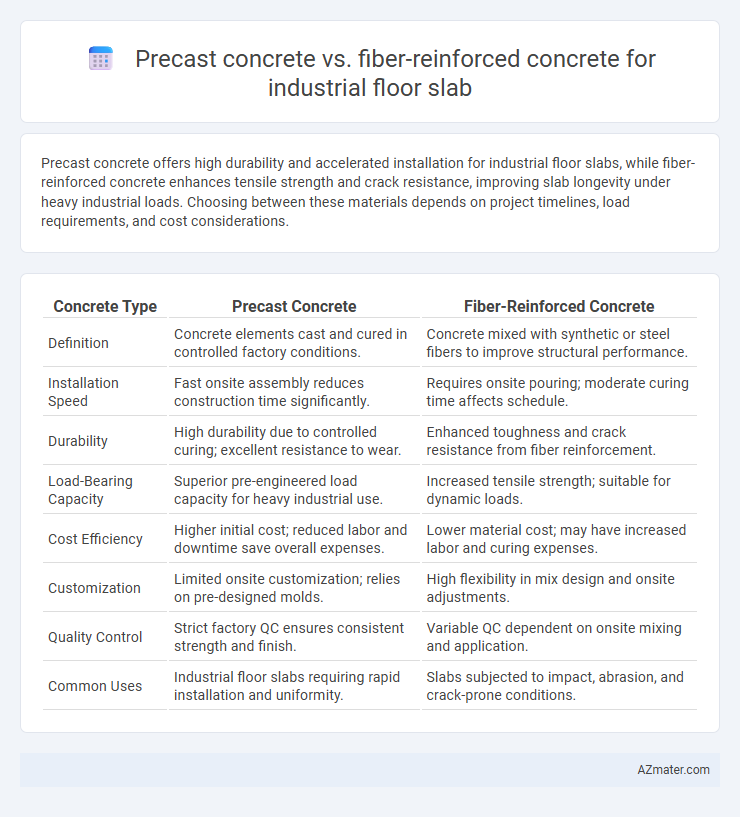Precast concrete offers high durability and accelerated installation for industrial floor slabs, while fiber-reinforced concrete enhances tensile strength and crack resistance, improving slab longevity under heavy industrial loads. Choosing between these materials depends on project timelines, load requirements, and cost considerations.
Table of Comparison
| Concrete Type | Precast Concrete | Fiber-Reinforced Concrete |
|---|---|---|
| Definition | Concrete elements cast and cured in controlled factory conditions. | Concrete mixed with synthetic or steel fibers to improve structural performance. |
| Installation Speed | Fast onsite assembly reduces construction time significantly. | Requires onsite pouring; moderate curing time affects schedule. |
| Durability | High durability due to controlled curing; excellent resistance to wear. | Enhanced toughness and crack resistance from fiber reinforcement. |
| Load-Bearing Capacity | Superior pre-engineered load capacity for heavy industrial use. | Increased tensile strength; suitable for dynamic loads. |
| Cost Efficiency | Higher initial cost; reduced labor and downtime save overall expenses. | Lower material cost; may have increased labor and curing expenses. |
| Customization | Limited onsite customization; relies on pre-designed molds. | High flexibility in mix design and onsite adjustments. |
| Quality Control | Strict factory QC ensures consistent strength and finish. | Variable QC dependent on onsite mixing and application. |
| Common Uses | Industrial floor slabs requiring rapid installation and uniformity. | Slabs subjected to impact, abrasion, and crack-prone conditions. |
Introduction to Industrial Floor Slab Solutions
Precast concrete offers high durability and rapid installation for industrial floor slabs, providing uniform quality control and reduced construction time. Fiber-reinforced concrete enhances tensile strength and crack resistance, improving slab performance under heavy loads and dynamic stresses typical in industrial environments. Both solutions optimize durability and structural integrity but differ in application speed and flexibility for industrial flooring needs.
Overview of Precast Concrete
Precast concrete for industrial floor slabs consists of factory-made panels or components, offering high compressive strength and controlled quality. It enables faster construction timelines with minimal on-site labor and consistent durability under heavy industrial loads. Precast slabs provide excellent resistance to wear, chemical exposure, and impact, making them ideal for manufacturing and warehouse environments.
Overview of Fiber-Reinforced Concrete
Fiber-reinforced concrete (FRC) incorporates synthetic or steel fibers to enhance toughness, crack resistance, and durability in industrial floor slabs. Its improved impact resistance and reduced shrinkage cracking make FRC ideal for high-traffic, heavy-load environments commonly found in warehouses and manufacturing plants. Compared to precast concrete, FRC allows for on-site casting with faster installation and minimal joints, resulting in seamless, robust flooring solutions.
Key Material Properties Comparison
Precast concrete offers high compressive strength, uniformity, and rapid installation for industrial floor slabs, benefiting from controlled factory conditions that reduce defects and enhance durability. Fiber-reinforced concrete integrates synthetic or steel fibers to improve tensile strength, crack resistance, and impact toughness, offering superior flexural performance under heavy industrial loads. Evaluating modulus of elasticity, shrinkage rates, and abrasion resistance reveals precast concrete excels in dimensional stability, while fiber-reinforced concrete provides enhanced toughness and reduced maintenance due to its superior crack control.
Installation Process and Construction Speed
Precast concrete offers rapid installation with factory-controlled quality, enabling modular sections to be quickly assembled on-site, significantly reducing construction time for industrial floor slabs. Fiber-reinforced concrete requires on-site pouring and curing, which extends the overall construction timeline, but eliminates jointing and reinforcement placement steps. The choice between precast and fiber-reinforced concrete depends on project schedule priorities, with precast favoring faster construction and fiber-reinforced concrete providing enhanced crack resistance during the curing process.
Durability and Long-Term Performance
Precast concrete offers high durability and consistent quality due to factory-controlled conditions, making it resistant to cracking and environmental wear for industrial floor slabs. Fiber-reinforced concrete enhances long-term performance by improving tensile strength and reducing shrinkage, thereby minimizing surface deterioration and increasing resistance to heavy loads and chemical exposure. Both materials contribute to extended service life, but fiber reinforcement is particularly beneficial in demanding industrial environments where impact resistance and crack control are critical.
Cost Analysis: Initial and Lifecycle Expenses
Precast concrete offers lower initial costs due to rapid onsite installation and reduced labor expenses compared to fiber-reinforced concrete, which typically involves higher material costs for synthetic or steel fibers. Fiber-reinforced concrete enhances durability and crack resistance, potentially decreasing long-term maintenance and repair costs in industrial floor slabs, contributing to favorable lifecycle expenses. Overall, precast concrete minimizes upfront investment, while fiber-reinforced concrete can provide better cost efficiency over the slab's operational lifespan due to increased performance and reduced downtime.
Sustainability and Environmental Impact
Precast concrete for industrial floor slabs reduces waste and energy use through controlled factory production, enhancing sustainability by minimizing site disruptions and material overuse. Fiber-reinforced concrete improves durability and crack resistance, extending slab lifespan and reducing the need for repair, which lowers overall environmental impact through less material consumption and reduced carbon footprint over time. Both materials contribute to sustainable construction, but fiber-reinforced concrete offers superior in-situ performance benefits, while precast concrete excels in resource efficiency and construction speed.
Best Applications for Each Concrete Type
Precast concrete is ideal for industrial floor slabs requiring rapid installation, high strength, and consistent quality, commonly used in warehouses and manufacturing plants with repetitive panel designs. Fiber-reinforced concrete excels in applications needing enhanced crack resistance and durability under heavy dynamic loads, such as industrial floors subject to frequent forklift traffic and impact from heavy machinery. Selecting between these materials depends on project timelines, load conditions, and the necessity for joint minimization or crack control.
Conclusion: Selecting the Optimal Solution
Precast concrete offers rapid installation and consistent quality, making it ideal for industrial floor slabs requiring fast turnaround and uniform strength. Fiber-reinforced concrete enhances durability and crack resistance, providing superior performance under heavy mechanical stress and impact loads. Choosing between the two depends on project priorities: precast concrete excels in speed and controlled manufacturing, while fiber-reinforced concrete delivers enhanced toughness and longevity in demanding industrial environments.

Infographic: Precast concrete vs Fiber-reinforced concrete for Industrial floor slab
 azmater.com
azmater.com